service indicator BMW X5 4.6IS 2003 Owners Manual
[x] Cancel search | Manufacturer: BMW, Model Year: 2003, Model line: X5 4.6IS, Model: BMW X5 4.6IS 2003Pages: 183, PDF Size: 2.31 MB
Page 4 of 183
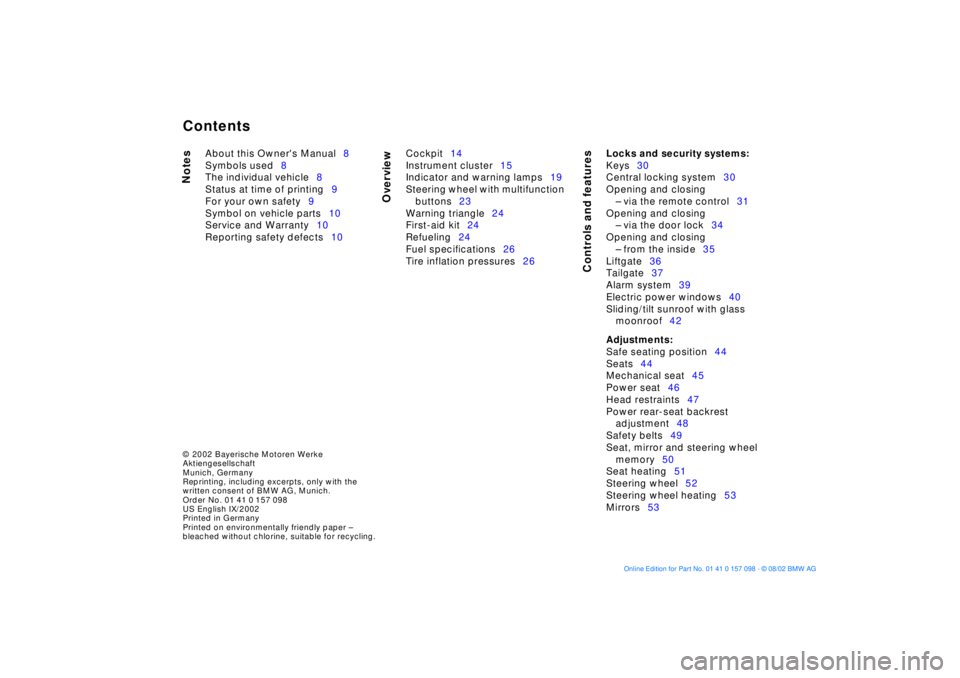
Contents
© 2002 Bayerische Motoren Werke
Aktiengesellschaft
Munich, Germany
Reprinting, including excerpts, only with the
written consent of BMW AG, Munich.
Order No. 01 41 0 157 098
US English IX/2002
Printed in Germany
Printed on environmentally friendly paper Ð
bleached without chlorine, suitable for recycling.
Notes
Overview
Controls and features
About this Owner's Manual 8
Symbols used 8
The individual vehicle 8
Status at time of printing 9
For your own safety 9
Symbol on vehicle parts 10
Service and Warranty 10
Reporting safety defects 10Cockpit
14
Instrument cluster 15
Indicator and warning lamps 19
Steering wheel with multifunction buttons 23
Warning triangle 24
First-aid kit 24
Refueling 24
Fuel specifications 26
Tire inflation pressures 26
Locks and security systems:
Keys30
Central locking system 30
Opening and closing Ð via the remote control 31
Opening and closing Ð via the door lock 34
Opening and closing Ð from the inside 35
Liftgate 36
Tailgate 37
Alarm system 39
Electric power windows 40
Sliding/tilt sunroof with glass moonroof 42
Adjustments:
Safe seating position 44
Seats 44
Mechanical seat 45
Power seat 46
Head restraints 47
Power rear-seat backrest adjustment 48
Safety belts 49
Seat, mirror and steering wheel
memory 50
Seat heating 51
Steering wheel 52
Steering wheel heating 53
Mirrors 53
Inhalt
Page 5 of 183
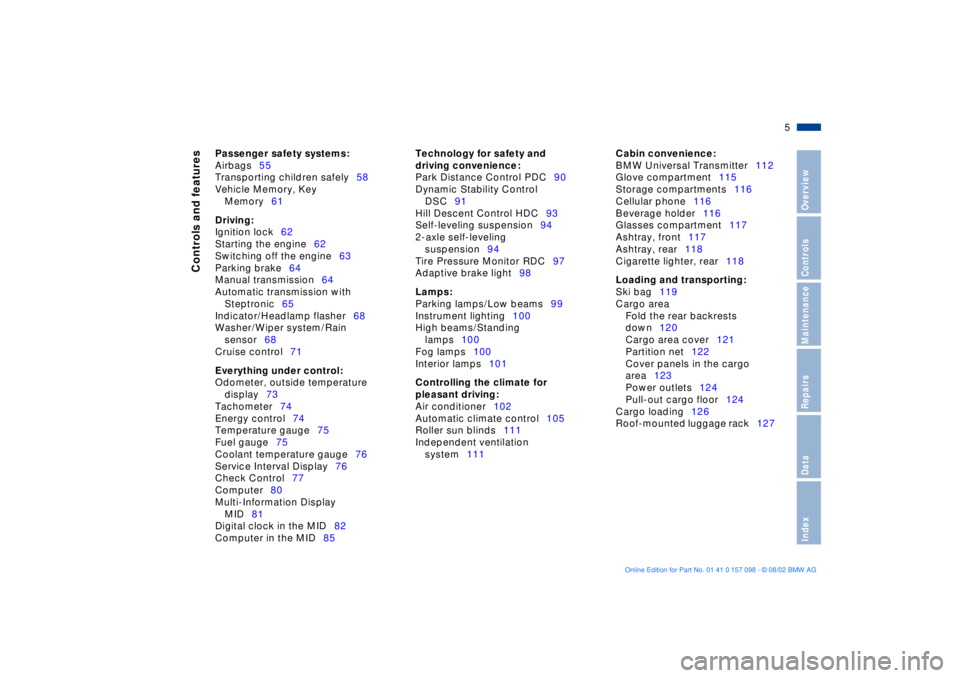
5n
OverviewControlsMaintenanceRepairsDataIndex
Controls and features
Passenger safety systems:
Airbags55
Transporting children safely58
Vehicle Memory, Key
Memory61
Driving:
Ignition lock62
Starting the engine62
Switching off the engine63
Parking brake64
Manual transmission64
Automatic transmission with
Steptronic65
Indicator/Headlamp flasher68
Washer/Wiper system/Rain
sensor68
Cruise control71
Everything under control:
Odometer, outside temperature
display73
Tachometer74
Energy control74
Temperature gauge75
Fuel gauge75
Coolant temperature gauge76
Service Interval Display76
Check Control77
Computer80
Multi-Information Display
MID81
Digital clock in the MID82
Computer in the MID85
Technology for safety and
driving convenience:
Park Distance Control PDC90
Dynamic Stability Control
DSC91
Hill Descent Control HDC93
Self-leveling suspension94
2-axle self-leveling
suspension94
Tire Pressure Monitor RDC97
Adaptive brake light98
Lamps:
Parking lamps/Low beams99
Instrument lighting100
High beams/Standing
lamps100
Fog lamps100
Interior lamps101
Controlling the climate for
pleasant driving:
Air conditioner102
Automatic climate control105
Roller sun blinds111
Independent ventilation
system111
Cabin convenience:
BMW Universal Transmitter112
Glove compartment115
Storage compartments116
Cellular phone116
Beverage holder116
Glasses compartment117
Ashtray, front117
Ashtray, rear118
Cigarette lighter, rear118
Loading and transporting:
Ski bag119
Cargo area
Fold the rear backrests
down120
Cargo area cover121
Partition net122
Cover panels in the cargo
area123
Power outlets124
Pull-out cargo floor124
Cargo loading126
Roof-mounted luggage rack127
Page 16 of 183
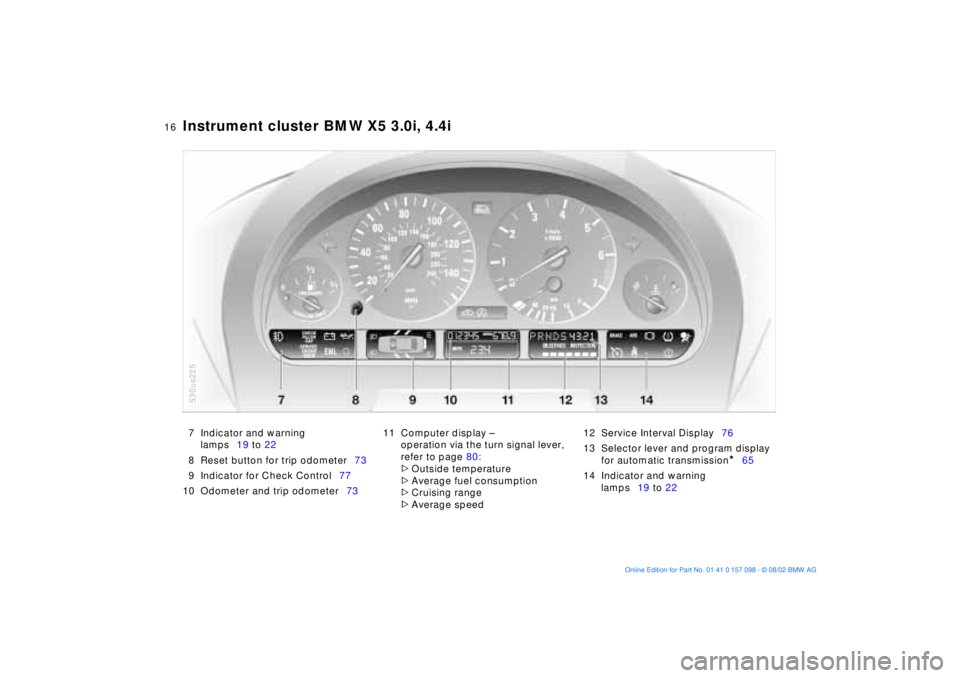
16n
Instrument cluster BMW X5 3.0i, 4.4i
7 Indicator and warning
lamps19 to 22
8 Reset button for trip odometer73
9 Indicator for Check Control77
10 Odometer and trip odometer7311 Computer display Ð
operation via the turn signal lever,
refer to page 80:
>
Outside temperature
>
Average fuel consumption
>
Cruising range
>
Average speed 12 Service Interval Display76
13 Selector lever and program display
for automatic transmission
*
65
14 Indicator and warning
lamps19 to 22
530us225
Page 17 of 183
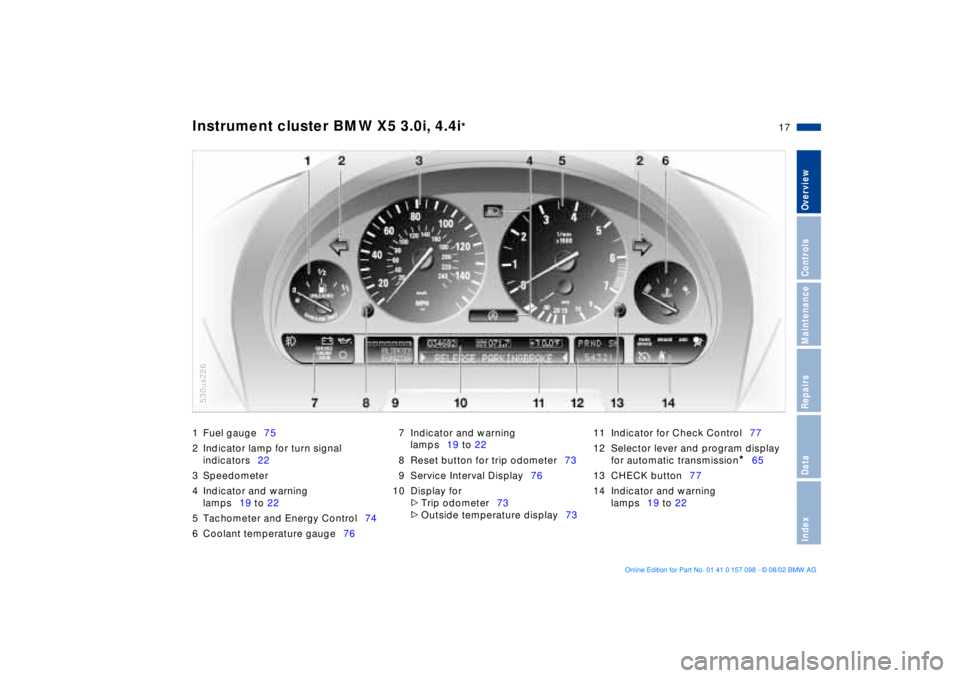
17n
OverviewControlsMaintenanceRepairsDataIndex
Instrument cluster BMW X5 3.0i, 4.4i
*
1 Fuel gauge75
2 Indicator lamp for turn signal
indicators22
3 Speedometer
4 Indicator and warning
lamps19 to 22
5 Tachometer and Energy Control74
6 Coolant temperature gauge767 Indicator and warning
lamps19 to 22
8 Reset button for trip odometer73
9 Service Interval Display76
10 Display for
>
Trip odometer73
>
Outside temperature display7311 Indicator for Check Control77
12 Selector lever and program display
for automatic transmission
*
65
13 CHECK button77
14 Indicator and warning
lamps19 to 22
530us226530us226
Page 18 of 183
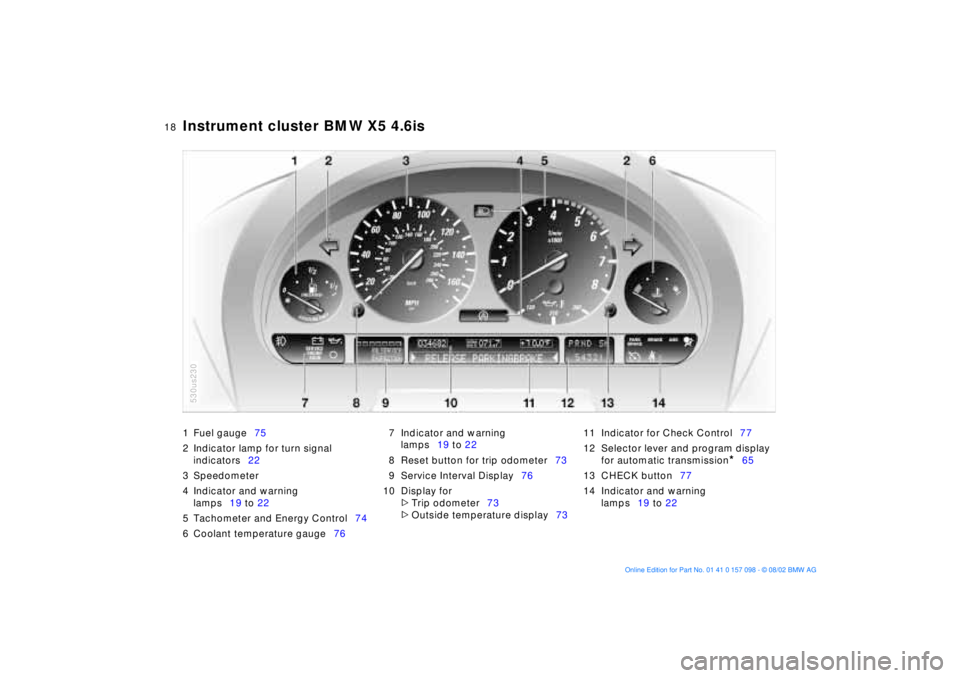
18n
Instrument cluster BMW X5 4.6is
1 Fuel gauge75
2 Indicator lamp for turn signal
indicators22
3 Speedometer
4 Indicator and warning
lamps19 to 22
5 Tachometer and Energy Control74
6 Coolant temperature gauge767 Indicator and warning
lamps19 to 22
8 Reset button for trip odometer73
9 Service Interval Display76
10 Display for
>
Trip odometer73
>
Outside temperature display7311 Indicator for Check Control77
12 Selector lever and program display
for automatic transmission
*
65
13 CHECK button77
14 Indicator and warning
lamps19 to 22
530us226530us230
Page 21 of 183
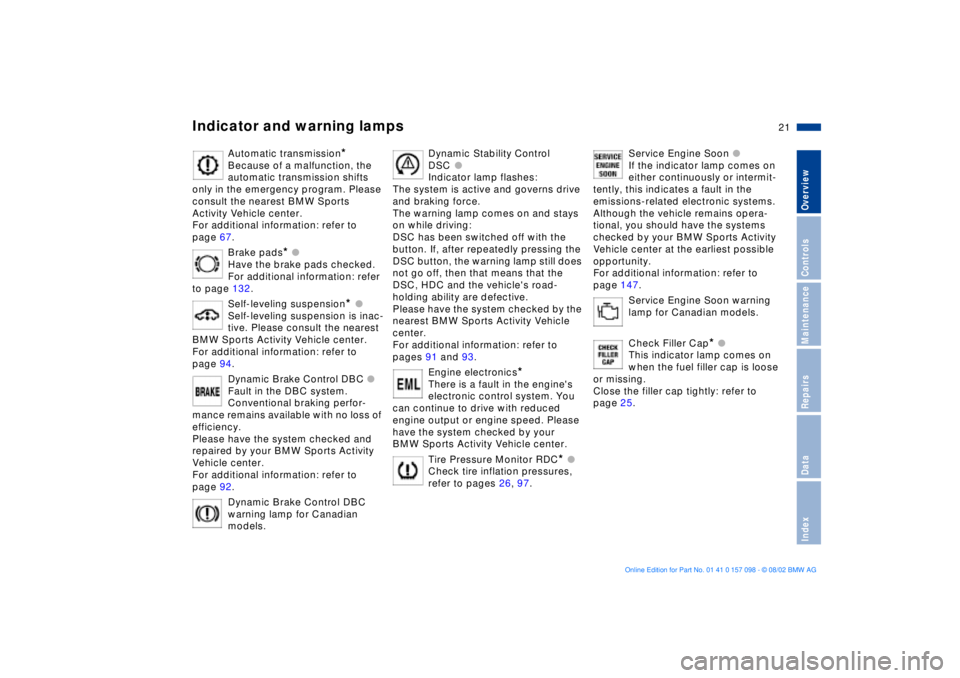
21n
OverviewControlsMaintenanceRepairsDataIndex
Indicator and warning lamps
Automatic transmission
*
Because of a malfunction, the
automatic transmission shifts
only in the emergency program. Please
consult the nearest BMW Sports
Activity Vehicle center.
For additional information: refer to
page 67.
Brake pads
*
l
Have the brake pads checked.
For additional information: refer
to page 132.
Self-leveling suspension
* l
Self-leveling suspension is inac-
tive. Please consult the nearest
BMW Sports Activity Vehicle center.
For additional information: refer to
page 94.
Dynamic Brake Control DBC l
Fault in the DBC system.
Conventional braking perfor-
mance remains available with no loss of
efficiency.
Please have the system checked and
repaired by your BMW Sports Activity
Vehicle center.
For additional information: refer to
page 92.
Dynamic Brake Control DBC
warning lamp for Canadian
models.
Dynamic Stability Control
DSC
l
Indicator lamp flashes:
The system is active and governs drive
and braking force.
The warning lamp comes on and stays
on while driving:
DSC has been switched off with the
button. If, after repeatedly pressing the
DSC button, the warning lamp still does
not go off, then that means that the
DSC, HDC and the vehicle's road-
holding ability are defective.
Please have the system checked by the
nearest BMW Sports Activity Vehicle
center.
For additional information: refer to
pages 91 and 93.
Engine electronics
*
There is a fault in the engine's
electronic control system. You
can continue to drive with reduced
engine output or engine speed. Please
have the system checked by your
BMW Sports Activity Vehicle center.
Tire Pressure Monitor RDC
* l
Check tire inflation pressures,
refer to pages 26, 97.
Service Engine Soon l
If the indicator lamp comes on
either continuously or intermit-
tently, this indicates a fault in the
emissions-related electronic systems.
Although the vehicle remains opera-
tional, you should have the systems
checked by your BMW Sports Activity
Vehicle center at the earliest possible
opportunity.
For additional information: refer to
page 147.
Service Engine Soon warning
lamp for Canadian models.
Check Filler Cap
* l
This indicator lamp comes on
when the fuel filler cap is loose
or missing.
Close the filler cap tightly: refer to
page 25.
Page 92 of 183
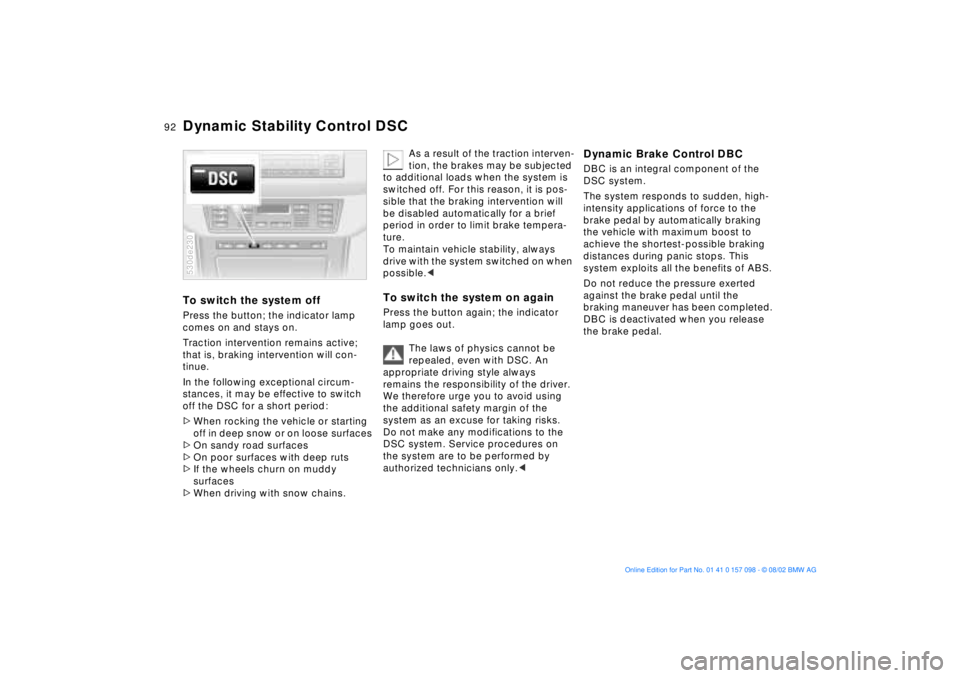
92n
Dynamic Stability Control DSCTo switch the system offPress the button; the indicator lamp
comes on and stays on.
Traction intervention remains active;
that is, braking intervention will con-
tinue.
In the following exceptional circum-
stances, it may be effective to switch
off the DSC for a short period:
>When rocking the vehicle or starting
off in deep snow or on loose surfaces
>On sandy road surfaces
>On poor surfaces with deep ruts
>If the wheels churn on muddy
surfaces
>When driving with snow chains. 530de230
As a result of the traction interven-
tion, the brakes may be subjected
to additional loads when the system is
switched off. For this reason, it is pos-
sible that the braking intervention will
be disabled automatically for a brief
period in order to limit brake tempera-
ture.
To maintain vehicle stability, always
drive with the system switched on when
possible.<
To switch the system on againPress the button again; the indicator
lamp goes out.
The laws of physics cannot be
repealed, even with DSC. An
appropriate driving style always
remains the responsibility of the driver.
We therefore urge you to avoid using
the additional safety margin of the
system as an excuse for taking risks.
Do not make any modifications to the
DSC system. Service procedures on
the system are to be performed by
authorized technicians only.<
Dynamic Brake Control DBCDBC is an integral component of the
DSC system.
The system responds to sudden, high-
intensity applications of force to the
brake pedal by automatically braking
the vehicle with maximum boost to
achieve the shortest-possible braking
distances during panic stops. This
system exploits all the benefits of ABS.
Do not reduce the pressure exerted
against the brake pedal until the
braking maneuver has been completed.
DBC is deactivated when you release
the brake pedal.
Page 134 of 183
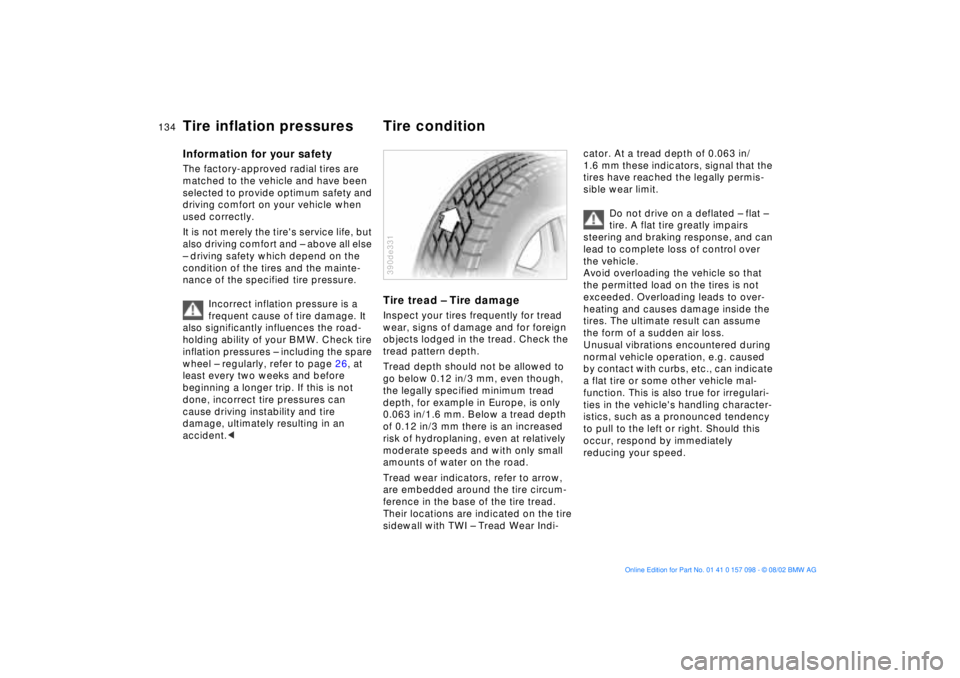
134n
Information for your safety The factory-approved radial tires are
matched to the vehicle and have been
selected to provide optimum safety and
driving comfort on your vehicle when
used correctly.
It is not merely the tire's service life, but
also driving comfort and Ð above all else
Ð driving safety which depend on the
condition of the tires and the mainte-
nance of the specified tire pressure.
Incorrect inflation pressure is a
frequent cause of tire damage. It
also significantly influences the road-
holding ability of your BMW. Check tire
inflation pressures Ð including the spare
wheel Ð regularly, refer to page 26, at
least every two weeks and before
beginning a longer trip. If this is not
done, incorrect tire pressures can
cause driving instability and tire
damage, ultimately resulting in an
accident.<
Tire tread Ð Tire damage Inspect your tires frequently for tread
wear, signs of damage and for foreign
objects lodged in the tread. Check the
tread pattern depth.
Tread depth should not be allowed to
go below 0.12 in/3 mm, even though,
the legally specified minimum tread
depth, for example in Europe, is only
0.063 in/1.6 mm. Below a tread depth
of 0.12 in/3 mm there is an increased
risk of hydroplaning, even at relatively
moderate speeds and with only small
amounts of water on the road.
Tread wear indicators, refer to arrow,
are embedded around the tire circum-
ference in the base of the tire tread.
Their locations are indicated on the tire
sidewall with TWI Ð Tread Wear Indi-390de331
cator. At a tread depth of 0.063 in/
1.6 mm these indicators, signal that the
tires have reached the legally permis-
sible wear limit.
Do not drive on a deflated Ð flat Ð
tire. A flat tire greatly impairs
steering and braking response, and can
lead to complete loss of control over
the vehicle.
Avoid overloading the vehicle so that
the permitted load on the tires is not
exceeded. Overloading leads to over-
heating and causes damage inside the
tires. The ultimate result can assume
the form of a sudden air loss.
Unusual vibrations encountered during
normal vehicle operation, e.g. caused
by contact with curbs, etc., can indicate
a flat tire or some other vehicle mal-
function. This is also true for irregulari-
ties in the vehicle's handling character-
istics, such as a pronounced tendency
to pull to the left or right. Should this
occur, respond by immediately
reducing your speed.
Tire inflation pressures Tire condition
Page 144 of 183
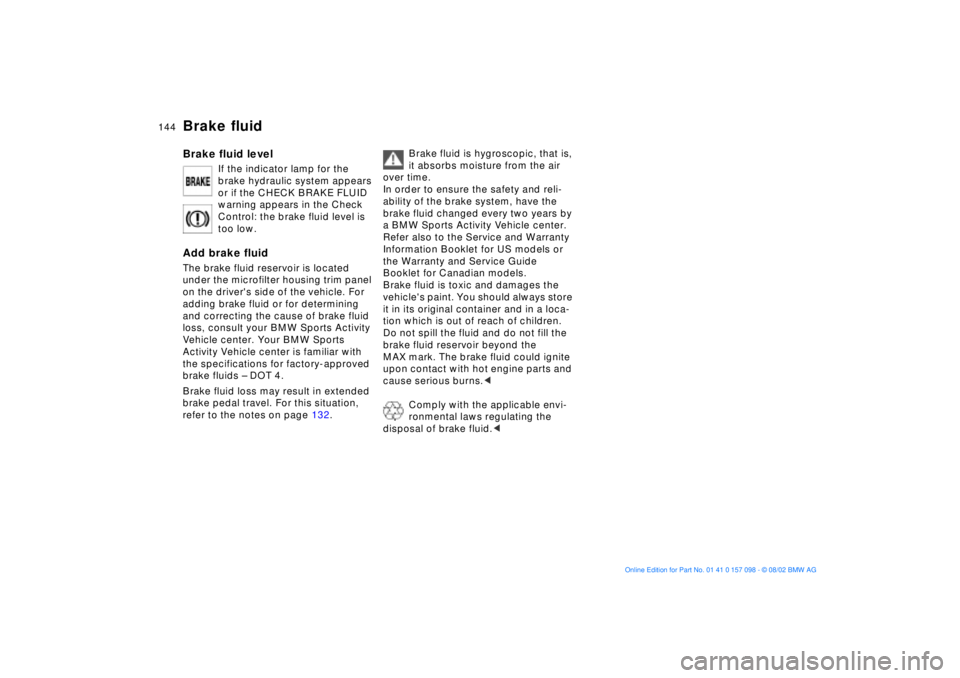
144n
Brake fluidBrake fluid level
If the indicator lamp for the
brake hydraulic system appears
or if the CHECK BRAKE FLUID
warning appears in the Check
Control: the brake fluid level is
too low.
Add brake fluidThe brake fluid reservoir is located
under the microfilter housing trim panel
on the driver's side of the vehicle. For
adding brake fluid or for determining
and correcting the cause of brake fluid
loss, consult your BMW Sports Activity
Vehicle center. Your BMW Sports
Activity Vehicle center is familiar with
the specifications for factory-approved
brake fluids Ð DOT 4.
Brake fluid loss may result in extended
brake pedal travel. For this situation,
refer to the notes on page 132.
Brake fluid is hygroscopic, that is,
it absorbs moisture from the air
over time.
In order to ensure the safety and reli-
ability of the brake system, have the
brake fluid changed every two years by
a BMW Sports Activity Vehicle center.
Refer also to the Service and Warranty
Information Booklet for US models or
the Warranty and Service Guide
Booklet for Canadian models.
Brake fluid is toxic and damages the
vehicle's paint. You should always store
it in its original container and in a loca-
tion which is out of reach of children.
Do not spill the fluid and do not fill the
brake fluid reservoir beyond the
MAX mark. The brake fluid could ignite
upon contact with hot engine parts and
cause serious burns.<
Comply with the applicable envi-
ronmental laws regulating the
disposal of brake fluid.<
Page 147 of 183
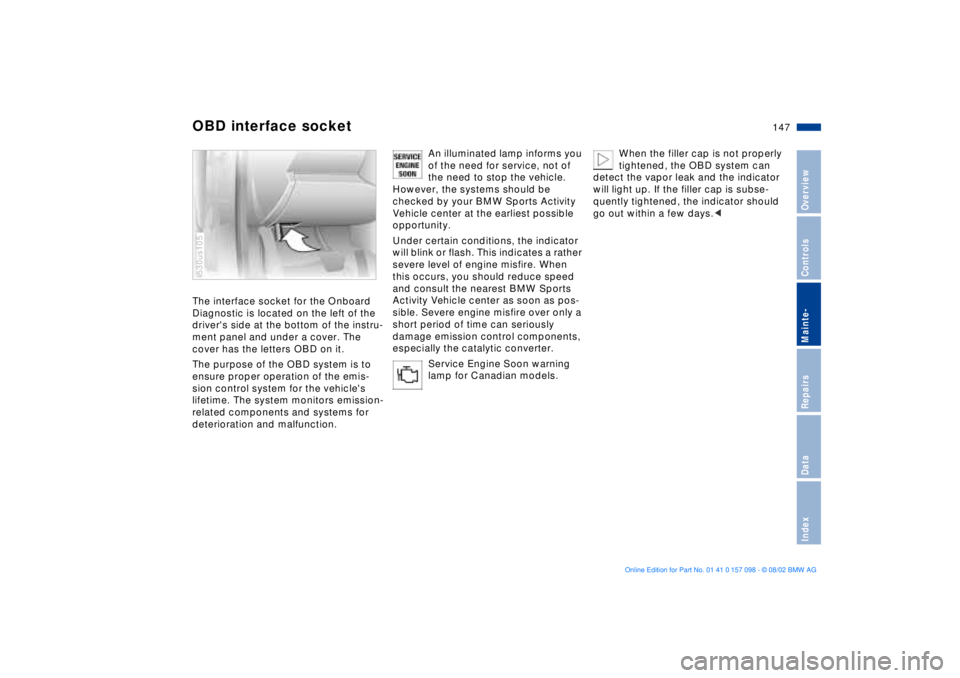
147n
OverviewControlsMainte-RepairsDataIndex
OBD interface socket The interface socket for the Onboard
Diagnostic is located on the left of the
driver's side at the bottom of the instru-
ment panel and under a cover. The
cover has the letters OBD on it.
The purpose of the OBD system is to
ensure proper operation of the emis-
sion control system for the vehicle's
lifetime. The system monitors emission-
related components and systems for
deterioration and malfunction.530us105
An illuminated lamp informs you
of the need for service, not of
the need to stop the vehicle.
However, the systems should be
checked by your BMW Sports Activity
Vehicle center at the earliest possible
opportunity.
Under certain conditions, the indicator
will blink or flash. This indicates a rather
severe level of engine misfire. When
this occurs, you should reduce speed
and consult the nearest BMW Sports
Activity Vehicle center as soon as pos-
sible. Severe engine misfire over only a
short period of time can seriously
damage emission control components,
especially the catalytic converter.
Service Engine Soon warning
lamp for Canadian models.
When the filler cap is not properly
tightened, the OBD system can
detect the vapor leak and the indicator
will light up. If the filler cap is subse-
quently tightened, the indicator should
go out within a few days.<